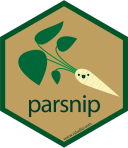03:00
3 - What makes a model?
Machine learning with tidymodels
Your turn

How do you fit a linear model in R?
How many different ways can you think of?
lmfor linear modelglmfor generalized linear model (e.g. logistic regression)glmnetfor regularized regressionkerasfor regression using TensorFlowstanfor Bayesian regressionsparkfor large data sets
To specify a model ![]()
- Choose a model
- Specify an engine
- Set the mode

To specify a model ![]()
To specify a model ![]()
- Choose a model
- Specify an engine
- Set the mode

To specify a model ![]()
To specify a model ![]()
To specify a model ![]()
- Choose a model
- Specify an engine
- Set the mode

To specify a model ![]()
To specify a model ![]()
All available models are listed at https://www.tidymodels.org/find/parsnip/
To specify a model ![]()
- Choose a model
- Specify an engine
- Set the mode

Your turn

Run the tree_spec chunk in your .qmd.
Edit this code so it creates a different model.
05:00
All available models are listed at https://www.tidymodels.org/find/parsnip/
Models we’ll be using today
- Linear regression
- Decision trees
Linear regression
Linear regression
Linear regression
- Outcome modeled as linear combination of predictors:
\(\mbox{latency} = \beta_0 + \beta_1\cdot\mbox{age} + \epsilon\)
- Find a line that minimizes the mean squared error (MSE)
Decision trees
Decision trees
Series of splits or if/then statements based on predictors
First the tree grows until some condition is met (maximum depth, no more data)
Then the tree is pruned to reduce its complexity
Decision trees
All models are wrong, but some are useful!
Linear regression
Decision trees
A model workflow
Workflows bind preprocessors and models

What is wrong with this?

Why a workflow()? ![]()
- Workflows handle new data better than base R tools in terms of new factor levels
- You can use other preprocessors besides formulas (more on feature engineering tomorrow!)
- They can help organize your work when working with multiple models
- Most importantly, a workflow captures the entire modeling process:
fit()andpredict()apply to the preprocessing steps in addition to the actual model fit
A model workflow ![]()
![]()
tree_spec <-
decision_tree() %>%
set_mode("regression")
tree_spec %>%
fit(latency ~ ., data = frog_train)
#> parsnip model object
#>
#> n= 456
#>
#> node), split, n, deviance, yval
#> * denotes terminal node
#>
#> 1) root 456 2197966.00 92.90351
#> 2) age>=4.947975 256 252347.40 60.89844
#> 4) treatment=control 131 91424.06 48.42748 *
#> 5) treatment=gentamicin 125 119197.90 73.96800 *
#> 3) age< 4.947975 200 1347741.00 133.87000
#> 6) treatment=control 140 986790.70 118.25710
#> 12) reflex=mid,full 129 754363.70 111.56590 *
#> 13) reflex=low 11 158918.20 196.72730 *
#> 7) treatment=gentamicin 60 247194.60 170.30000
#> 14) age< 4.664439 30 102190.20 147.83330
#> 28) age>=4.566638 22 53953.86 129.77270 *
#> 29) age< 4.566638 8 21326.00 197.50000 *
#> 15) age>=4.664439 30 114719.40 192.76670 *A model workflow ![]()
![]()
tree_spec <-
decision_tree() %>%
set_mode("regression")
workflow() %>%
add_formula(latency ~ .) %>%
add_model(tree_spec) %>%
fit(data = frog_train)
#> ══ Workflow [trained] ════════════════════════════════════════════════
#> Preprocessor: Formula
#> Model: decision_tree()
#>
#> ── Preprocessor ──────────────────────────────────────────────────────
#> latency ~ .
#>
#> ── Model ─────────────────────────────────────────────────────────────
#> n= 456
#>
#> node), split, n, deviance, yval
#> * denotes terminal node
#>
#> 1) root 456 2197966.00 92.90351
#> 2) age>=4.947975 256 252347.40 60.89844
#> 4) treatment=control 131 91424.06 48.42748 *
#> 5) treatment=gentamicin 125 119197.90 73.96800 *
#> 3) age< 4.947975 200 1347741.00 133.87000
#> 6) treatment=control 140 986790.70 118.25710
#> 12) reflex=mid,full 129 754363.70 111.56590 *
#> 13) reflex=low 11 158918.20 196.72730 *
#> 7) treatment=gentamicin 60 247194.60 170.30000
#> 14) age< 4.664439 30 102190.20 147.83330
#> 28) age>=4.566638 22 53953.86 129.77270 *
#> 29) age< 4.566638 8 21326.00 197.50000 *
#> 15) age>=4.664439 30 114719.40 192.76670 *A model workflow ![]()
![]()
tree_spec <-
decision_tree() %>%
set_mode("regression")
workflow(latency ~ ., tree_spec) %>%
fit(data = frog_train)
#> ══ Workflow [trained] ════════════════════════════════════════════════
#> Preprocessor: Formula
#> Model: decision_tree()
#>
#> ── Preprocessor ──────────────────────────────────────────────────────
#> latency ~ .
#>
#> ── Model ─────────────────────────────────────────────────────────────
#> n= 456
#>
#> node), split, n, deviance, yval
#> * denotes terminal node
#>
#> 1) root 456 2197966.00 92.90351
#> 2) age>=4.947975 256 252347.40 60.89844
#> 4) treatment=control 131 91424.06 48.42748 *
#> 5) treatment=gentamicin 125 119197.90 73.96800 *
#> 3) age< 4.947975 200 1347741.00 133.87000
#> 6) treatment=control 140 986790.70 118.25710
#> 12) reflex=mid,full 129 754363.70 111.56590 *
#> 13) reflex=low 11 158918.20 196.72730 *
#> 7) treatment=gentamicin 60 247194.60 170.30000
#> 14) age< 4.664439 30 102190.20 147.83330
#> 28) age>=4.566638 22 53953.86 129.77270 *
#> 29) age< 4.566638 8 21326.00 197.50000 *
#> 15) age>=4.664439 30 114719.40 192.76670 *Your turn

Run the tree_wflow chunk in your .qmd.
Edit this code so it uses a linear model.
05:00
Predict with your model ![]()
![]()
How do you use your new tree_fit model?
Your turn

Run:
predict(tree_fit, new_data = frog_test)
What do you get?
03:00
Your turn

Run:
augment(tree_fit, new_data = frog_test)
What do you get?
03:00
The tidymodels prediction guarantee!
- The predictions will always be inside a tibble
- The column names and types are unsurprising and predictable
- The number of rows in
new_dataand the output are the same
Understand your model ![]()
![]()
How do you understand your new tree_fit model?
Understand your model ![]()
![]()
How do you understand your new tree_fit model?
You can extract_*() several components of your fitted workflow.
Understand your model ![]()
![]()
How do you understand your new tree_fit model?
You can use your fitted workflow for model and/or prediction explanations:
- overall variable importance, such as with the vip package
- flexible model explainers, such as with the DALEXtra package
Learn more at https://www.tmwr.org/explain.html
Your turn

Extract the model engine object from your fitted linear workflow.
⚠️ Never predict() with any extracted components!
05:00
Deploy your model ![]()
Deploying a model ![]()
How do you use your new tree_fit model in production?
Learn more at https://vetiver.rstudio.com
Deploy your model ![]()
How do you use your new model tree_fit in production?
library(plumber)
pr() %>%
vetiver_api(v)
#> # Plumber router with 3 endpoints, 4 filters, and 1 sub-router.
#> # Use `pr_run()` on this object to start the API.
#> ├──[queryString]
#> ├──[body]
#> ├──[cookieParser]
#> ├──[sharedSecret]
#> ├──/logo
#> │ │ # Plumber static router serving from directory: /Users/emilhvitfeldt/Library/R/arm64/4.2/library/vetiver
#> ├──/metadata (GET)
#> ├──/ping (GET)
#> └──/predict (POST)Learn more at https://vetiver.rstudio.com
Your turn

Run the vetiver chunk in your .qmd.
Check out the automated visual documentation.
05:00


